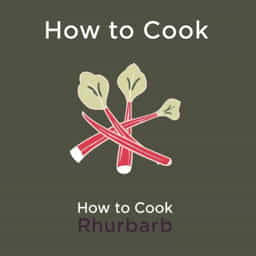Cooking rhubarb may seem intimidating if you’ve only seen it in desserts or jams. While its naturally tart flavor is unmistakable, when prepared properly rhubarb transforms into a versatile ingredient full of depth and brightness. Learning how to cook rhubarb opens up options from classic compotes and crumbles to savory sauces and cocktails. With simple techniques and clear timing, you can bring out the best balance of sweet and tangy tones that make rhubarb magical in the kitchen. Here’s a complete guide to cooking rhubarb, including prepping tips, timing, serving ideas, and flavor pairings for every style of dish.
Understanding Rhubarb: What You Need to Know
Rhubarb is a distinctively red or green stalk vegetable known for its sharp, tart taste. Technically a vegetable, it’s most commonly prepared like a fruit. Only the stalks are edible rhubarb leaves contain toxic substances and should never be eaten. The natural acidity and firm texture mean it thrives when paired with sugar, fruit, or creamy elements in both sweet and savory recipes.
When Is Rhubarb in Season?
Rhubarb is typically available in spring and early summer, with peak flavor between April and June in temperate climates. Fresh stalks should feel crisp, firm, and vibrant in color. Avoid wilted or soft stems. Frozen rhubarb is also widely available and works well in most cooked preparations.
Prepping Rhubarb for Cooking
- Trim away the leafy tops and base use only the stalks.
- Wash thoroughly and pat dry.
- Slice into pieces about 1 to 2 cm thick (½ inch) depending on recipe.
- If stalks are very thick and fibrous, peel the outer layer before slicing.
Prepping rhubarb carefully ensures even cooking and a pleasant texture in the finished dish.
Basic Cooking Methods for Rhubarb
Stewing Rhubarb
Stewed rhubarb is soft, saucy, and ideal as a dessert base or topping for yogurt, ice cream, or pancakes.
- Combine chopped stalks with sugar (1/4 to 1/2 cup sugar per 500¯g rhubarb), and a splash of water in a saucepan.
- Heat gently over medium-low flame, stirring occasionally.
- Cook for 5-10 minutes until the stalks are soft but still hold shape.
- Optionally add vanilla, citrus zest, or spices like cinnamon for complexity.
Roasting Rhubarb
Roasting concentrates rhubarb’s flavor and caramelizes the edges slightly. Great when served with cream or crumbles.
- Preheat oven to 200¯Â°C (400¯Â°F).
- Toss sliced rhubarb with sugar (or honey), a little oil or butter, and optional citrus zest.
- Spread in a single layer on a baking tray, roast for 15-20 minutes, rotating halfway.
- Remove when tender and lightly browned.
Poaching Rhubarb
Poaching in spiced syrup yields beautifully flavored, intact stalks perfect for pairing with desserts or sipping.
- Simmer water with sugar, vanilla, and spices like star anise or ginger.
- Add whole or halved stalks and reduce heat to low.
- Poach gently for 8-12 minutes until slightly soft but not falling apart.
Flavor Pairings and Enhancements
Rhubarb’s tartness pairs wonderfully with sweet, creamy, or rich flavors.
- Strawberries or raspberries help balance acidity.
- Citrus fruits like orange or lemon brighten the dish further.
- Ginger, cardamom, cinnamon add warmth.
- Honey or maple syrup offer natural sweetness.
- Cream, mascarpone, or yogurt bring richness and balance.
- Herbs like mint or basil lend fresh contrast.
Recipes and Serving Ideas
Classic Rhubarb Compote
- Makes a great topping for porridge, ice cream, or toast.
- Stew rhubarb with equal parts sugar and water, add vanilla, cook until saucy.
- Serve warm or cold. Lasts up to five days in fridge.
Rhubarb Crumble or Crisp
- Layer stewed rhubarb and strawberry in ovenproof dish.
- Top with crumble made from oats, flour, butter, and sugar.
- Bake at 180¯Â°C (350¯Â°F) for 25-30 minutes until golden and bubbly.
Savory Rhubarb Sauce
Simmer rhubarb with onions, garlic, vinegar, sugar, and herbs until saucy. Perfect with roasted pork or grilled fish.
Rhubarb Drink or Mocktail
Use poached rhubarb syrup or juice shaken with sparkling water, honey, and ice for a refreshing summer beverage.
Timing Guide for Cooking Rhubarb
- Stewing: 5-10 minutes
- Roasting: 15-20 minutes at 200¯Â°C
- Poaching: 8-12 minutes simmering gently
Check texture frequently during cooking rhubarb is ready when fork-tender but before it dissolves completely unless you want a purée.
Storing Cooked Rhubarb
Refrigerate cooled rhubarb in a sealed container for up to five days. Freeze stews or compotes for up to three months. If freezing, consider adding a bit of sugar or syrup to preserve texture and color.
Tips for Success
- Always trim and discard leaves they are poisonous.
- Adjust sugar to taste; if rhubarb is especially tart, use more.
- Watch cooking closely overcooking leads to mush.
- For firmer pieces, cook over lower heat with minimal stirring.
- Experiment with pairings strawberry rhubarb is a classic for good reason.
Knowing how to cook rhubarb unlocks a world of sweet, tangy, and savory possibilities. Whether you choose to stew it quickly for compote, roast for deep flavor, or poach for delicate stalks, the key is timing, quality ingredients, and complementary pairings. From classic desserts to innovative sauces and beverages, cooked rhubarb adds brightness and sophistication to your cooking. With these detailed methods and tips, you’ll be confident creating dishes that highlight rhubarb’s bold character in balanced and delicious ways.
